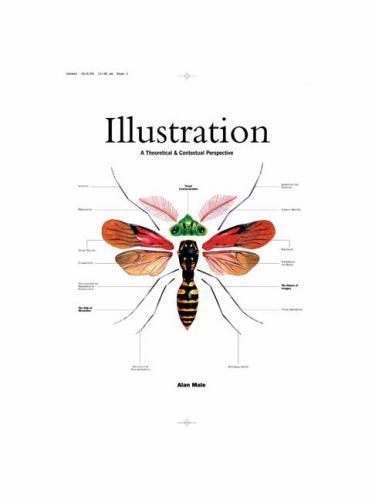Picture 1 of 1

Stock photo

Picture 1 of 1

Stock photo

Required Reading Range Ser.: Illustration : A Theoretical and Contextual Perspective by Alan Male (2007, Trade Paperback)
B
Brenham Book Company (1489)
94.8% positive feedback
Price:
$70.15
+ $4.25 shipping
Returns:
30 days returns. Buyer pays for return shipping. If you use an eBay shipping label, it will be deducted from your refund amount.
Condition:
Illustration: A Theoretical and Contextual Perspective is a comprehensive guide to contemporary illustration. It provides readers with an understanding of the theory, research, conceptual processing and contexts involved in illustration practice. This book describes a variety of definitions and philosophies of illustration, together with a relevant historical overview. Illustration introduces the notion of the illustrator as a socially and culturally aware communicator: an able professional with knowledge, understanding and insight regarding the context within which they are working and the subject matter that they are engaged with.
Oops! Looks like we're having trouble connecting to our server.
Refresh your browser window to try again.
About this product
Product Identifiers
PublisherBloomsbury Publishing
ISBN-102940373515
ISBN-139782940373512
eBay Product ID (ePID)59061360
Product Key Features
Number of Pages216 Pages
Publication NameIllustration : a Theoretical and Contextual Perspective
LanguageEnglish
SubjectGraphic Arts / Illustration
Publication Year2007
TypeTextbook
Subject AreaDesign
AuthorAlan Male
SeriesRequired Reading Range Ser.
FormatTrade Paperback
Dimensions
Item Height0.7 in
Item Weight40.9 Oz
Item Length11.8 in
Item Width8.9 in
Additional Product Features
Intended AudienceCollege Audience
ReviewsFull of beautiful illustrations, the book is a fascinating and thought provoking read, which is a clear 'must have' for any aspiring or established illustrator. If focuses on illustration, education and theory, especially helpful for both undergraduate and post-graduate study and research.
Dewey Edition22
IllustratedYes
Dewey Decimal741.6
Table Of ContentIntroduction: The Illustrator. Education: The Programme of Work - An overview; Developing a brief; Answering the brief; The conceptual process; Research; Drawing. The nature of imagery: Visual language; Visual metaphor; Pictorial truths; Aesthetics and non-aesthetics. The role of illustration: Documentation, reference and instruction; Commentary; Storytelling; Persuasion; Identity. Appendix: Glossary; Appendices; Notes & sketches; Index; Bibliography; Acknowledgements.
SynopsisIllustration: A Theoretical and Contextual Perspective is a comprehensive guide to contemporary illustration. It provides readers with an understanding of the theory, research, conceptual processing and contexts involved in illustration practice. This book describes a variety of definitions and philosophies of illustration, together with a relevant historical overview. Illustration introduces the notion of the illustrator as a socially and culturally aware communicator: an able professional with knowledge, understanding and insight regarding the context within which they are working and the subject matter that they are engaged with., Successful, forward-thinking illustrators no longer operate the way many did and still do, as merely colouring-in technicians, receiving briefs that are heavily directed and prescribed regarding content and overall visual concept. Nowadays, illustrators need to be educated, socially and culturally aware communicators, having knowledge, understanding and insight regarding the context within which they are working, the subject matter that they are engaged with, and to be able professionals working within the parameters and needs of the market place and target audiences. They need to utilise a breadth of intellectual and practical skills some that might once be regarded as transferable from other disciplines, but are now considered essential if the illustrator has ambitions to transcend the basic role of commissioned hack. This book introduces the concept of the illustrator as a specialist or authority on a particular subject or as an originator of either fiction and/or non-fiction material. Examples include- effective and creative written communication and authorship, academic research, art direction and design management. The book focuses on illustration, education and theory, in particular the latter stages of undergraduate development and post-graduate study and research- such as theoretical and intellectual processes, research and visual language. Definitions and philosophies of what illustration is are also featured, together with a relevant historical overview., Successful, forward-thinking illustrators no longer operate the way many did and still do, as merely colouring-in technicians, receiving briefs that are heavily directed and prescribed regarding content and overall visual concept. Nowadays, illustrators need to be educated, socially and culturally aware communicators, having knowledge, understanding and insight regarding the context within which they are working, the subject matter that they are engaged with, and to be able professionals working within the parameters and needs of the market place and target audiences. They need to utilise a breadth of intellectual and practical skills some that might once be regarded as transferable from other disciplines, but are now considered essential if the illustrator has ambitions to transcend the basic role of commissioned hack. This book introduces the concept of the illustrator as a specialist or authority on a particular subject or as an originator of either fiction and/or non-fiction material. Examples include: effective and creative written communication and authorship, academic research, art direction and design management. The book focuses on illustration, education and theory, in particular the latter stages of undergraduate development and post-graduate study and research: such as theoretical and intellectual processes, research and visual language. Definitions and philosophies of what illustration is are also featured, together with a relevant historical overview., Used to be that illustrators were told how and what to draw, and they drew it, and that was that. Today, however, illustrators are the authority; they are the originators of the ideas and the images that convey those ideas, both in fiction and in nonfiction. They need to be educated, socially and culturally aware communicators, with knowledge, understanding, and insight. "Illustration" shows emerging and exploring illustrators how to approach a new project, the theoretical and intellectual processes involved, the value of research, and how to create a unique visual language. Definitions and philosophies of illustration are also featured, along with an historical overview. Straightforward yet inspiring, this book is a must-have for illustrators everywhere.
LC Classification NumberNC960
All listings for this product
Be the first to write a review


























